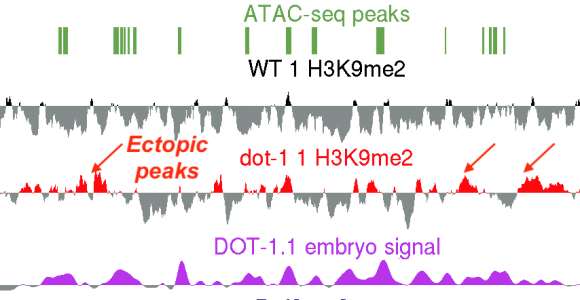A new study from the Grishok lab: “Caenorhabditis elegans Deficient in DOT-1.1 Exhibit Increases in H3K9me2 at Enhancer and Certain RNAi-Regulated Regions” by Ruben Esse and Alla Grishok has recently been published in a Special issue of journal Cells (MDPI) “Heterochromatin Formation and Function”. The lab has previously shown that Histone H3 lysine 79 methyltransferase DOT-1.1 (an orthologue of human DOT1L) is localized to developmental enhancers in nematodes and promotes lineage-specific, most notably neural, gene expression. The new report describes ectopic deposition of a heterochromatin mark at the enhancers in the absence of DOT-1.1 and H3K79 methylation and suggests that H3K79 methylation “poises” developmental genes for future activation by lineage-specific transcription factors. Notably, the known role of DOT1L in promoting HOXA gene expression (both in normal and cancer contexts) fits the general model of developmental gene activation by DOT1L suggested by the new study by Esse and Grishok.
Special issue of journal Cells (MDPI) “Heterochromatin Formation and Function”. The lab has previously shown that Histone H3 lysine 79 methyltransferase DOT-1.1 (an orthologue of human DOT1L) is localized to developmental enhancers in nematodes and promotes lineage-specific, most notably neural, gene expression. The new report describes ectopic deposition of a heterochromatin mark at the enhancers in the absence of DOT-1.1 and H3K79 methylation and suggests that H3K79 methylation “poises” developmental genes for future activation by lineage-specific transcription factors. Notably, the known role of DOT1L in promoting HOXA gene expression (both in normal and cancer contexts) fits the general model of developmental gene activation by DOT1L suggested by the new study by Esse and Grishok.